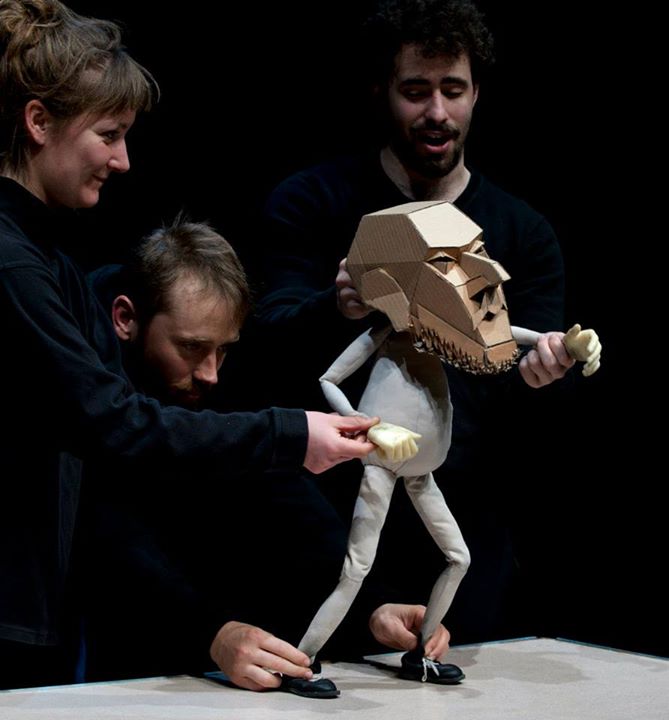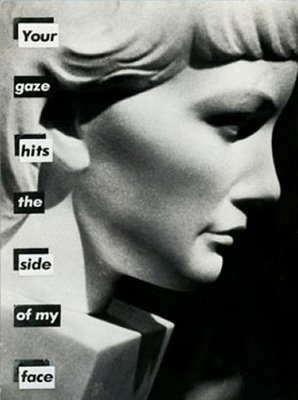One politically incorrect British puppet, one sturdy American table and three improvising puppeteers. As our Bunraku puppet hero points out, no expenses were spared in the making of this evening.
It’s a show – about a puppet – on a table. 
As the puppet keeps reiterating at the beginning, that’s really all that happens in the 70 minutes of this show. And what’s impressive is that it actually works.
So many productions nowadays on TV, film, or even theater emphasize the spectacle element with special effects overloading the senses of the viewers. Instead of aiding the storytelling process, the effects take front and center while the story is relegated to the back burner. The Table by the Blind Summit Theater is a welcome departure from this trend, exploring the basics of storytelling and what it means to be human using only the bare necessities.
The basic premise is that our protagonist puppet is undergoing an existential crisis because “all [he] gets asked to do are birthday parties and reenactments of some folktales set in Eastern Europe!” Our puppet wants people to know that he’s got dreams; he just doesn’t know what they are. So when a London-based Jewish organization tapped him to enact the life of Moses, our puppet was more than happy to comply. This is where the show gets its Bible inspiration—throughout the show, we return loosely to points of Moses’ life, but we never stay there for long.
What the show really turns out to be is an investigation of what it means to be alive. The puppet is quick to point out that “[he’s] not actually alive—it’s just a series of intricate movements!” In one of my favorite sequences of the show, the puppet and the puppeteers demonstrate what exactly these movements are, and how they can manipulate them. At one point, our puppet even demands his operators to lie him down (it’s okay, he’s a professional, he won’t die) and the puppeteers comply. We see that our puppet can still exist without a direct physical component—in fact, losing his ‘body’ is almost a liberation of sorts, freeing his existence from many physical restrictions. In a snap second he can change his size and do crazy contortions, which makes for a very interesting picture when the physical puppet is lying down on a side of the table yet his presence is still on the stage.
Of course, it’s the three puppeteers who make all of this happen. One takes his bum and right arm, another person takes his feet and the third puppeteer voices him and moves his head and left arm. It takes three puppeteers to bring one puppet to life, and it’s amazing how it’s all done in improv. At one point in the show, because one of the puppeteers are “busy in the bathroom,” the company asks one of the audience members to come down and replace him; even with this new element, the puppeteers make the illusion of life quite convincing. It shows how intricate their collaborative process is, involving acting upon and interacting with each other’s movements.
They’re not shy to reveal that they’re just following three basic rules—focus, breathing, and fixed point. Focus refers to what is being looked at on the stage; by the puppeteers keeping their eyes on the puppet throughout the show, the audience in turn is forced to focus on the puppet and makes him come alive. Breathe in—hold—breathe out; breathing serves as the basis of all movements, so all of their actions are based on the process of breathing. Fixed point is similar, but it refers to the organization of movement.
So there’s really not that much to recreating life on stage, which is what theater is supposed to do. Just three basic rules, that’s it. And life too—in one of my favorite moments of the show, our puppet pulls himself together in the midst of a breakdown by reminding himself to focus and to breathe in, hold, breathe out. Sometimes it’s so easy to get bogged down by the weight of your own existence or just life itself, but nothing’s really that complicated—just focus, breathe in, hold, breathe out. Huh. Even I didn’t realize that this show had such a semi-deep message; it just kept me laughing for 70 minutes. That’s the magic of this show—that it’s so approachable and at the same time, funny—and it certainly fulfills what Blind Summit sets out to do: “presenting new puppets in new places in new ways to new audiences, seeing puppetry as a radical part of the reinvention of theater in our time.”


 Overall, Bell (who wrote, directed, starred in, and produced the film) utilizes dialogue and words very effectively. There are some interesting snippets utilizing the interplay between words and the visual—Gustav saying “culture was my education,” while doing clearly uncultured things, Louis having to resort to flailing his arms for Carol’s attention when Carol doesn’t stop talking. Another interesting element is the use of phone conversations to further various plot threads at once; simultaneous situations that sometimes parallel each other and at other times contrast with each other are woven together elegantly.
Overall, Bell (who wrote, directed, starred in, and produced the film) utilizes dialogue and words very effectively. There are some interesting snippets utilizing the interplay between words and the visual—Gustav saying “culture was my education,” while doing clearly uncultured things, Louis having to resort to flailing his arms for Carol’s attention when Carol doesn’t stop talking. Another interesting element is the use of phone conversations to further various plot threads at once; simultaneous situations that sometimes parallel each other and at other times contrast with each other are woven together elegantly.